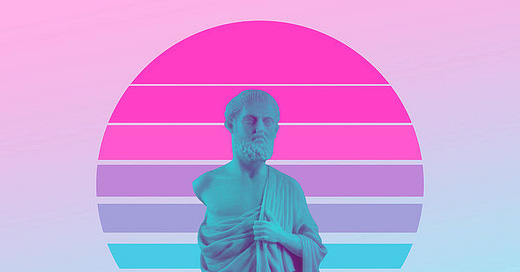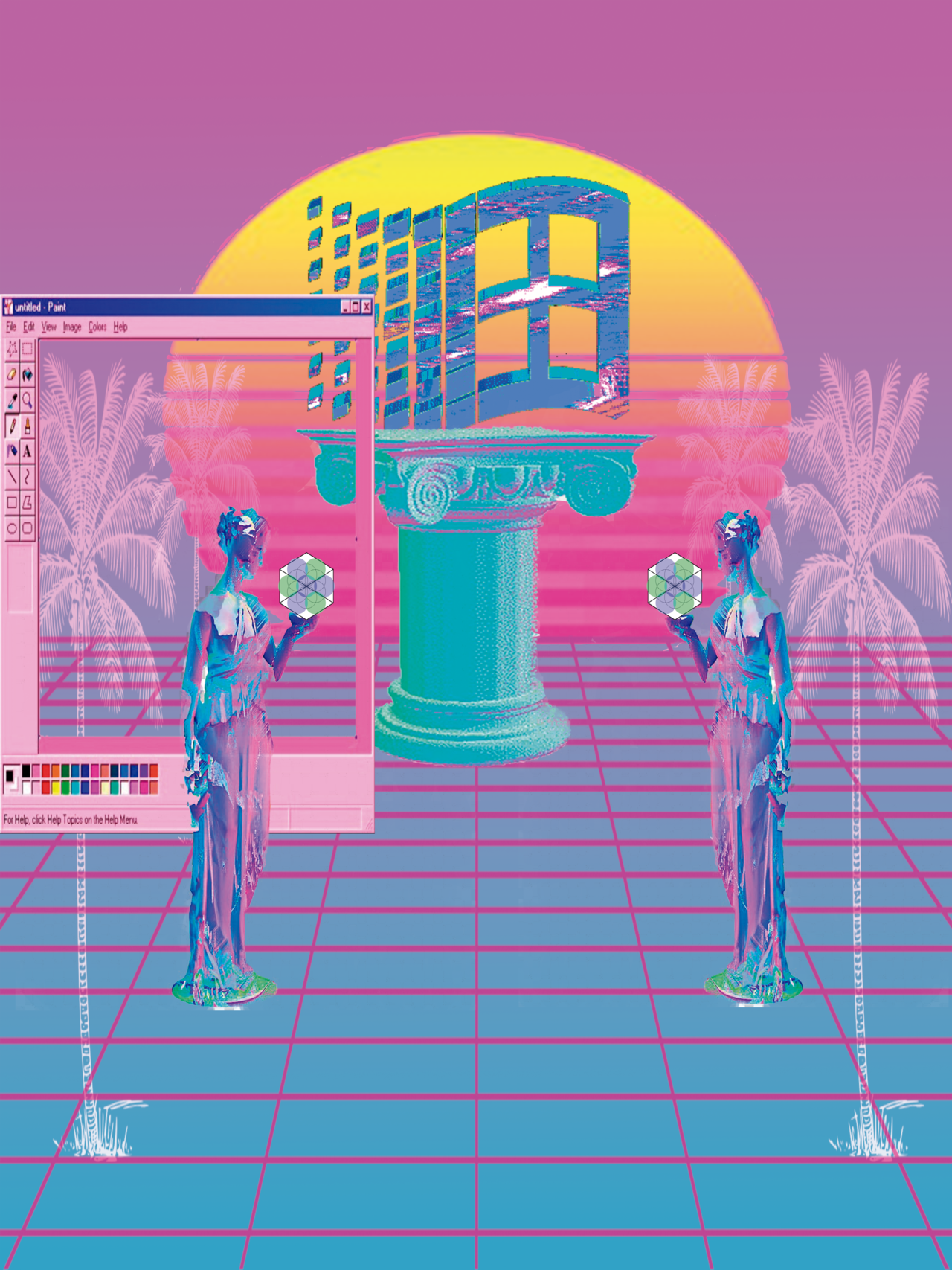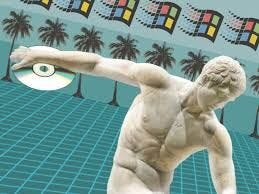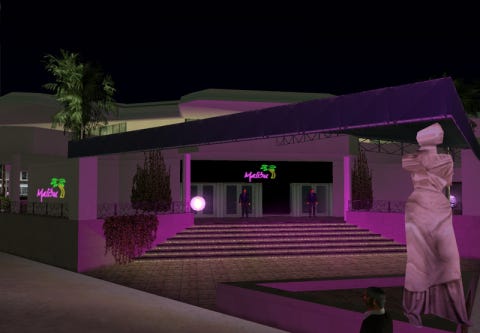Rabbit Hole #2: Vaporwave
Why is classical Greek sculpture used so much in this meme of an aesthetic? 🏺
Hi all! I published a couple things outside this newsletter recently:
an essay/meditation about infinity, and the scarce feeling of it
a reflection about the future of architecture, arguing that we should incorporate classical elements into our visions of tomorrow. This is part of a new online magazine called The Classical Futurist that two friends and I launched today. It’s a super cool project and I’m really excited about it.
Today’s Rabbit Hole is directly related to The Classical Futurist. In researching aesthetics that combine the future and classical antiquity, I stumbled upon a genre of music and visual arts called vaporwave. Vaporwave is from the early 2010s, but I apparently wasn’t cool enough to know about it until now.
So this exploration is like a historian’s: we’ll examine this small, recent bit of art history — focussing on the visual part, because many have written about the music, and also I don’t have the time to listen to enough music for me to say anything intelligent. In any case, I want to focus on the “classical sculpture” part of the aesthetic, which is a bit of a mystery, as it doesn’t fit the rest of the aesthetic that much.
Vaporwave was born somewhere between 2009 and 2011. The most emblematic piece of media was, and remains, the album Floral Shoppe by Macintosh Plus, a.k.a. Vektroid, a.k.a. Ramona Andra Xavier, released in December of 2011.
You can join 2.5 million people and listen to part of it here. As you can see (or, well, hear), vaporwave music is similar to electronic lo-fi music. Or since I said I wouldn’t talk about the music much, let someone else do the talking:
an eerie amalgam of loungy elevator muzak, television, advertisements, infomercials, and video game samples
There, that’s a much better string of descriptors than I could have come up with.
Visually, the cover of Floral Shoppe is mostly pink, has its title and artist written in Japanese (the artist isn’t Japanese), contains a checkerboard that is reminiscent of early computer graphics, shows some sort of blurry cityscape, and, most conspicuously, features a bust of the Greek god of the sun Helios.

This choice of visuals is intriguing. Clearly vaporwave relies on nostalgia. But for the most part it’s 1980s and 1990s nostalgia: the time when Japan was a rising cultural influence, when computers were just gaining widespread adoption, when everyone used Windows and when every kid played with Microsoft Paint.
So why is there some 300s BC nostalgia mixed in?
One possible reason is contrast. All the visual elements of the Floral Shoppe cover except Helios are trashy and low-brow. On their own, they wouldn’t necessarily be super interesting. Add in a classic bust from the Greek civilization, and suddenly, there is class; the impact is striking; we enter the world of fine art.
It is also a parody of kitsch and overdecoration. To the extent that it has a philosophy, vaporwave denounces consumerism. It satirizes pop culture and capitalism. As a Reddit user puts it, as an answer to why Macintosh Plus used the bust of Helios in the first place:
I'm not entirely sure since she's been inconsistent on her intentions of all her vapor work. I've read that she's said the New Dreams Ltd. project is meant to be a joke on hipsters that would listen to literally anything, and then she's said that 札幌コンテンポラリー is a legitimate parody of consumerism. I think her use of the statue has to do with its connotations towards fine art. It's just hard to decipher what's sincere and what's not.
At this point in the discussion we must note that vaporwave is not only a musical and visual genre: it is also an internet meme. I mean, it has a Know Your Meme entry. Wikipedia describes it as a meme multiple times and cites Born and Haworth:
Vaporwave's cultural practices knowingly replicate and parody the addictive, almost compulsory participation that feeds social networks, where the voluntary labor of the user community drives the system and generates value. Anyone with an Internet connection can produce vaporwave ... The uniformity of these memes is encouraged by their rapid imitation among the genre's hyperactive online subculture, fueled by affective contagion.
Macintosh Plus turned out to be influential in seeding the subculture. So people copied her, and we get such art as
and
and
and
There is also merch:


Is that it, then? One influential artist incorporates classical art in her album cover, and then everyone imitates her?
That’s probably what happened. After all, it isn’t the most central point of the aesthetic. There’s plenty of vaporwave art that has no Greco-Roman imagery (and some would say it is better that way; the art that does tends to be considered in poor taste, because it imitates without innovating much).
But surely we can come up with more interesting theories. What if the copying was done because it points to something artistically interesting?
Let’s check Reddit again. Someone suggests that the classical designs come from the early internet:
to me it seems that the Greek or Roman statues and ancient themes in general were simply a part of early internet website design. I'm not sure why, perhaps it had to do with the fact that many early websites were operated by universities and colleges that referenced ancient scientists and philosophers?
Someone else in another thread:
I feel like it ties into a lot of the "old software" look, actually. I remember Greco-Roman sculptures and art showing up a lot on "wow you can buy this encyclopedia on CD ROM!" or "use the Internet to LEARN!" kind of things.
It's the sort of image that helped to communicate "I have information about history" and was the sort of thing a graphic designer in 1996 might already have on hand.
Another cites the beauty of Greek sculpture as a metaphor for the dreamy, easy listening qualities of vaporwave:
I mean I imagine it having to do with how Classical Greek art was heavily considered with effortless beauty. Many Greek sculpture's subjects look extremely serene, which fits with the subdued and dreamlike sides of vaporwave. Idk bout columns tho
Yet another Reddit user brings up the Malibu Club in Vice City, the fictional setting of Grand Theft Auto: Vice City. The in-game year is 1986, and sure enough, there is a Greek statue in front of the pink neon-lit club:
Was Greco-Roman sculpture particularly widespread in the 1980s? Hard to say for sure; I wasn’t there. The Reddit thread assumes so, in any case.
Whatever the case may be, the omnipresence of ancient fine art in 1980s and 1990s design and, by extension, vaporwave, is supremely interesting to me — not least because I just wrote a whole essay about classical revivalism. In that work, I researched and gave an overview of the many instances of classical comebacks in architecture. Ever since the Western Roman Empire collapsed, Europeans have sought to revive its aesthetics time and time again, from the Carolingian Renaissance to the Italian Renaissance to the Neoclassicism of the 18th and 19th centuries. But starting in the first half of the 20th century, we stopped doing so, at least when it comes to architecture.
Vaporwave shows that elements of ancient classical art can crop up in the most unexpected places, such as music genres that spread like internet memes. It shows that the cultural foundation of Western civilization is never far beyond the surface.
All the more reason to wish its grand return in the making of our cities.











